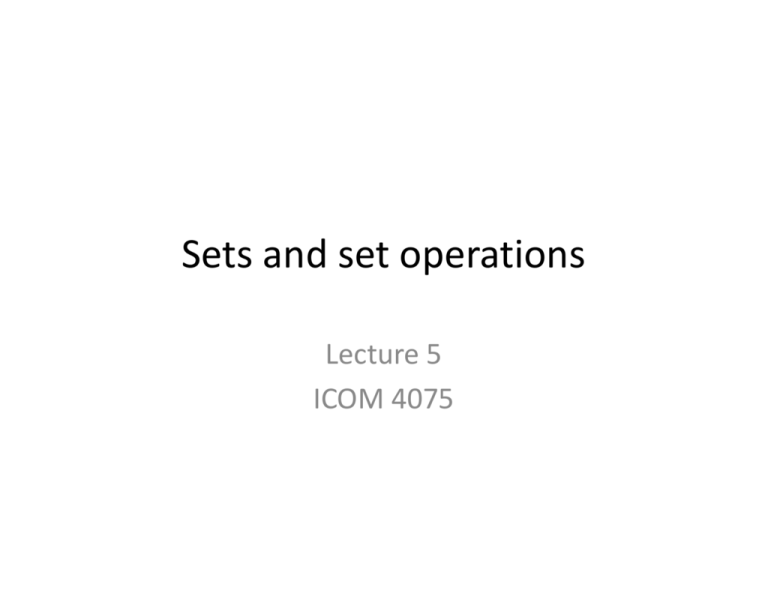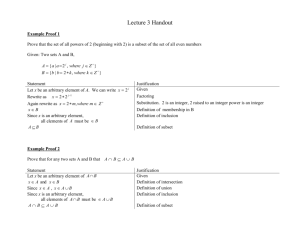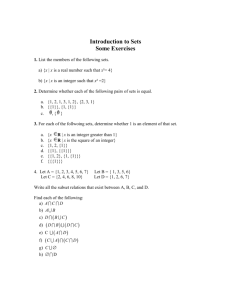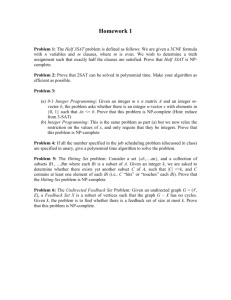Sets and set operations
advertisement

Sets and set operations
Lecture 5
ICOM 4075
Reviewing sets
As defined in a previous lecture, a set is a
collection of objects that constitute the
elements of the set
– We say that a set contains its elements, and
that an element belongs to its set
If S is a set and x an element in S, we
write
– xЄS
Examples of sets
1. The set of integers: {…, -3, -2, -1, 0, 1, 2, 3, …}
2. The set of the vowels in the Latin alphabet:
{a, e, i, o, u}
3. The set of all real solutions of the equation
x⁴ + y⁴ = 1
4. The set of 6 foot tall people
5. The set with no elements: this is the so-called
empty set, and is denoted by φ
Describing sets
a) By listing: this is, providing a list (sometimes partial
list or mere pattern of formation) of the elements
Example: Integers = {…, -3, -2 , -2, 0, 1, 2, 3,…}
b) By property: this is, by providing a logical statement
(property) that characterizes membership in the
set. In this case, an element x is in the set if the
statement is true for x and it is not if the statement
Property = logical statement
is false
– Example: A = {x : x is an integer and x⁴ + 1 is even}
1ЄA, since 1⁴+1 = 2;
3ЄA since 3⁴+1=82; etc…
Equality of sets
Definition: Two sets are equal if they have
the same elements. If S and R are sets
and they are equal, then we write S = R
Examples:
–{1, 2, 3} = {3, 1, 2}
–{a, b, a} = {a, b}
–{a, c} ≠ {a}
Implications of equality
As illustrated in the previous examples,
(as a consequence of the definition of
equality between sets) we have that in
sets:
–Repeated elements do not count
(repetitions are ignored)
–There is no particular order of the
elements in a set
Finite and infinite sets
A set is finite if it has a finite number of elements or if
it is the empty set. Otherwise, the set is said to be
infinite
Examples:
– The set of vowels in the Latin alphabet is finite
since it has only 5 elements
– The set of people 20 foot tall is finite since it is
empty
– The set of integers is infinite
Subsets
Definition: If A and B are sets and every
element in A is also an element in B, we
say that A is a subset of B. If A is a subset
of B we write:
A⊂B
Remark: The empty set is a subset of any
set
The power set
Definition: The power set of a set A is the set of
all subsets of A (includes the empty set and
the set itself). The power set of A is denoted
by pow(A)
Example: Let A = {1, 2, 3}. The subsets of A are:
φ, {1}, {2}, {3}, {1, 2}, {1, 3}, {2, 3}, and A itself.
Thus,
pow( A ) = {φ, {1}, {2}, {3}, {1, 2}, {1, 3}, {2, 3}, A}
Proof strategies with subsets and
equalities
Following are useful strategies for proving
logical statements asserting that two sets are
equal or that one set is a subset of another
set:
Statement to prove
Strategy
A is a subset of B
For arbitrary x in A, show that x is also in B
A is not a subset of B
Find an element in A that is not an element in B
A equals B
Show that A is a subset of B and B is a subset of A
A is not equal to B
Find an element in A that is not in B or an element in
B that is not in A
Example 1
Prove that A is subset of B where
A = {x : x = 1 / (3n + 6), for some natural n}
B = {x : x = 1 / n, for some natural n}
Proof: If x is an element in A, then there is a natural
number q such that x = 1 / (3q + 6).
A generic element in A
So, x = 1 / 3(q + 2) or what is the same
Just a
bit of
x = 1 / 3k, where k = q + 2 is a natural number.
algebra
Therefore, x = 1 / n with n = 3k, a natural number.
Conclusion: x is in B.
The generic element in A
satisfies the condition of
membership in B
Example 2
Let A = {x : x = 3k + 4, k integer} and
B = {x : x = 5k + 6, k integer}.
Is A subset of B or B subset of A?
Answer: Neither A is subset of B nor B is subset of A.
Proof: 7 is in A, since 3∙1+4 = 7. But,
7 is not in B since 7 =5k+6 implies k = 1/5 which is not integer.
So, A is not a subset of B.
Reciprocally, 11 is in B since 5∙1+6 = 11. But,
11 is not in A since 11 = 3k+4 implies k = 7/3 which is not
integer.
So, B is not a subset of A.
Example 3
Let A = {x : x is prime and 12 ≤ x ≤ 18} and
B = {x : x = 4 ∙ k + 1 and k = 3 or k = 4}
Prove that A = B.
Proof: First prove that A is a subset of B:
Note that A = {13, 17} since these are the primes that satisfy
the property.
But, 13 = 4 ∙ 3 + 1 and 17 = 4 ∙ 4 + 1.
Therefore, 13 is in B and 17 is in B.
Reciprocally, if k = 3, 4 ∙ k + 1 = 4 ∙ 3 + 1 = 13. Now, 13 is prime
and 12 ≤ 13 ≤ 18. So, 13 is in A.
Also, if k = 4, 4 ∙ k + 1 = 4 ∙ 4 + 1 = 17. But, 17 is prime and 12 ≤
17 ≤ 18. So, 17 is in A
Set operations
The main set operations are
Union of sets
Intersection of sets
Complement of a set
The union of two sets
Definition: given two sets A and B, their union is
the set A U B defined as
A U B = {x: x in A or x in B}
Example 1: Let A = {a, b, c, d} and B = {a, e, f}.
Then, A U B = {a, b, c, d, e, f}
Example 2: Let A be the even numbers and B be
the odd numbers. Then,
A U B is the set of natural numbers
Properties of union
1. A ∪φ = A
2. A ∪ B = B ∪ A
3. A ∪ (B ∪ C) = (A ∪ B) ∪ C
4. A ∪ A = A
5. A ⊆ B if andonlyif A ∪ B = B
Proving some of these properties
These properties (as any other property)
are logical statements about sets and
operations. This is, they are ultimately
mathematical statements.
We’ll prove a one of them. Let’s take for
example, properties 5.
Proof of property 3
Remark: Note that property is and if and only if
statement, and therefore, there are two implications
involved. These are:
(a) If A ⊆ B then A ∪ B = B
(b) If A ∪ B = B then A ⊆ B
Proof of (a):
The thesis is a equality of sets. We’ll prove it by
proving that: A ∪ B ⊆ B, and
B ⊆ A∪B
Proof of (a) (continuation)
If x ∈ A ∪ B, then x ∈ A or x ∈ B.
Since by hypothesis A ⊆ B, we have that
if x ∈ A, then x ∈ B.
Therefore, if x ∈ A ∪ B, then x ∈ B.
This is, A ∪ B ⊆ B.
Reciprocally, if x ∈ B then x ∈ B or x ∈ A;
therefore, B ⊆ A ∪ B.
So, A ∪ B = B.
Proof of (b)
The implication is now : If A ∪ B = B then, A ⊆ B.
We use the contrapositive : If A ⊄ B then A ∪ B ≠ B.
Proof of the contrapositive :
If A ⊄ B, then there is an element x∈ A such that x ∉ B.
But then, x ∈ A ∪ B but x ∉ B.
Therefore A ∪ B and B do not have the same elements.
This is, A ∪ B ≠ B.
Infinite unions
Definition: Let A₁, A₂, A₃,… be an infinite
collection of sets. Their union is define as the
∞
set:
U A i = {x : x ∈ A i , for some i ≥ 1}
i =1
Example: Let
A i = {−2i, 2i}, i = 1,2,3,...
Thus, A1 = {−2, 2}; A 2 = {−4, 4}; A 3 = {−6, 6}, etc...
∞
Now, U A i = {...,-10, - 8, - 6, - 4, - 2, 2, 4, 6, 8, 10, ...}
i =1
Intersections
Definition: The intersection of two sets A and B
is defined to be the set
A ∩ B = {x : x ∈ A and x ∈ B}
Example:
Let A = {n : n is integer and n = 3k + 7 for some integer k}
and let B = {m : m is integer and m = 4k + 5 for some integer k}
Then A ∩ B = {n : n = 3k + 7 = 4k + 5, for some integer k}
Is there a solution?
Yes! Pick k = 2. Then 3k + 7 = 13 = 4k + 5.
Therefore, A ∩ B = {13}.
Properties of the intersection of
two sets
1. A ∩ φ = φ
2. A ∩ B = B ∩ A
3. (A ∩ B) ∩ C = A ∩ (B ∩ C)
4. A ∩ A = A
5. A ⊆ B if and only if A ∩ B = A
Further examples
1. Let A = {x : x is integer and x = 20 for some integer k}
k
and let B the set of all integers.
Then A ∩ B = {-20, - 10, - 5, - 4, - 2, 2, 4, 5, 10, 20}
2. Let A = {y : y = (x - 1) 2 + 2 for some real number x}
and let B = {z : z = -2x + 3 for some real number x}.
Then, A ∩ B = {3} since if y = z then
(x - 1) 2 + 2 = −2x + 3
x 2 − 2x + 1 + 2 = -2x + 3
x 2 + 3 = 3. This is, x = 0. By replacing in both equations : y = z = 3.
Infinite intersections
Definition : The intersection of an infinite collection
A1 , A 2 , A 3 ,... of sets is defined to be the set :
∞
IA
i
= {x : x is an element of A i for all i}
i =1
Example :
Let A i = {x : x is integer and - i ≤ x ≤ i} where i is a
positive even number. Then,
∞
IA
i=2
i
= {−2, 0, 2}
Complement of a set
Definition: The complement of a set always
refer to sets that are subsets of a particular set
U, called universe, universal set or “universe
of discourse”.
Thus, if A ⊆ U, the complement of A,
denoted A' ,
is defined to be the set
A' = {x ∈ U : x ∉ A}
Example
Let A be the set of odd numbers. If U is chosen
to be the set of naturals, then
A’={ 0, 2, 4, 6, … }, this is, the set of all even
numbers
But if U is chosen to be the set of all real
numbers, then
A’={x: x real and x ≠ 2n+1 for any n natural}
Operational properties:
Combining union and intersection
1. A ∩ ( B ∪ C) = (A ∩ B) ∪ (A ∩ C)
2. A ∪ ( B ∩ C) = (A ∪ B) ∩ (A ∪ C)
Illustration of 1. : Let A = {1, 2, 3}, B = {a, b, 2, 3} and
C = {1, 2, b, c}. Then,
A ∩ (B ∪ C) = {1, 2, 3}∩ ({a, b, 2, 3} ∪ {1, 2, b, c})
= {1, 2, 3} ∩ {a, b, c,1, 2, 3}
= {1, 2, 3}
(A ∩ B) ∪ (A ∩ C) = ({1, 2, 3}∩{a, b, 2, 3}) ∪ ({1, 2, 3}∩{1, 2, b, c})
= {2, 3}∪{1, 2}
= {1, 2, 3}
Properties of complement
1. (A' )' = A
2. φ ' = U and U' = φ
3. A ∩ A' = φ and A ∪ A' = U
4. A ⊆ B if and only if B' ⊆ A'
5. (A ∪ B)' = A' ∩ B'
6. (A ∩ B)' = A' ∪ B'
De Morgan’s
LAWS
Illustration of De Morgan’s laws
Let A = {a, o, 3, 7}, B = {a, e, i, o, 1, 3, 5, 7}
with universe U = {a, e, i, o, u, 0, 1, 2, 3, 4, 5, 6, 7, 8, 9}.
Then, (A ∪ B)' = {a, e, i, o, 1, 3, 5, 7}'
= {u, 0, 2, 4, 6, 8, 9}
A' ∩ B' = {e, i, u, 0, 1, 2, 4, 5, 6, 8, 9} ∩ {u, 0, 2, 4, 6, 8, 9}
= {u, 0, 2, 4, 6, 8, 9}
Summary
•
•
•
•
•
•
•
Notion of set, set descriptions
Set equality and its implications
Finite sets and infinite sets
Subsets, power set
Proof strategies with subsets and set equalities
Operations with sets: definitions and properties
Properties of combined operations
Exercises
1. Describe each of the following sets in terms of a
property
1. A = {1, 5, 9, 13,…}
2. B = {…, -8, -5, -2, 1, 4, 7, … }
3. C = {1, 2, 5, 10, 17,…,82}
2. Write down the power set for each of the following
sets
1. A = pow({a, b})
2. A = {a, {a, b}, φ}
3. A = {φ, {φ}}
Exercises (cont.)
3. Is it true that power(A∪ B) = power(A)∪ power(B) ?
{x : x is integer and x < -i or x > i}, if i is even
4. Let Ai =
{x : x is integer and - i < x < i}, if i is odd
1. Find the union of the collection{Ai : i natural}
2. Find the intersection of the collection{Ai : i natural}
3. Find the union of the collection{Ai : i = 1, 2, 3, 4, 5}
4. Find the intersection of the collection{Ai : i = 1,3,5,7}






